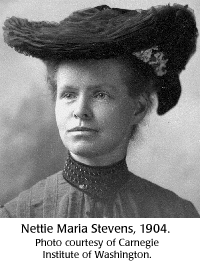Concept 9 Specialized chromosomes determine sex.

 Nettie Maria Stevens and Edmund Beecher Wilson both independently developed the idea of sex determination by chromosomes. Their work established the importance of chromosomes in heredity and helped Thomas Hunt Morgan interpret the early genetic results from Drosophila.
Nettie Maria Stevens and Edmund Beecher Wilson both independently developed the idea of sex determination by chromosomes. Their work established the importance of chromosomes in heredity and helped Thomas Hunt Morgan interpret the early genetic results from Drosophila.
Nettie Maria Stevens (1861-1912)

Nettie Stevens was one of the first female scientists to make a name for herself in the biological sciences. She was born in Cavendish, Vermont. Her family settled in Westford, Massachusetts. Stevens' father was a carpenter and handyman. He did well enough to own quite a bit of Westford property, and could afford to send his children to school.
Stevens was a brilliant student, consistently scoring the highest in her classes. In 1896, Stevens went to California to attend Leland Stanford University. She graduated with a masters in biology. Her thesis involved a lot of microscopic work and precise, careful detailing of new species of marine life. This training was a factor in her success with later investigations of chromosomal behavior.
After Stanford, Stevens went to Bryn Mawr College for more graduate work. Thomas Hunt Morgan was still teaching at Bryn Mawr, and was one of her professors. Stevens again did so well that she was awarded a fellowship to study abroad. She traveled to Europe and spent time in Theodor Boveri's lab at the Zoological Institute at Würzburg, Germany. Boveri was working on the problem of the role of chromosomes in heredity. Stevens likely developed an interest in the subject from her stay.
In 1903, Stevens got her Ph.D. from Bryn Mawr, and started looking for a research position. She was eventually given an assistantship by the Carnegie Institute after glowing recommendations from Thomas Hunt Morgan, Edmund Wilson and M. Carey Thomas, the president of Bryn Mawr. Her work on sex determination was published as a Carnegie Institute report in 1905. In this first study she looked at sex determination in meal worms. Later, she studied sex determination in many different species of insects.
Stevens' assistantship at Bryn Mawr still meant that she had to teach. She wanted a pure research position, and wrote to Charles Davenport to see if it was possible for her to work at his Station for Experimental Biology. Unfortunately, Stevens died of breast cancer in 1912 before she could occupy the research professorship created for her at Bryn Mawr, or work with Davenport at Cold Spring Harbor.


To prove the fertilizing power of semen (which contain sperm), in 1784, scientists put pants on male frogs before allowing them to mate. It was noted that the resulting eggs never developed.

Why have a reduction system for meiosis? Why not just "destroy" one set of chromosomes to produce sex cells?
 Children resemble their parents.
Children resemble their parents. Genes come in pairs.
Genes come in pairs. Genes don't blend.
Genes don't blend. Some genes are dominant.
Some genes are dominant. Genetic inheritance follows rules.
Genetic inheritance follows rules. Genes are real things.
Genes are real things. All cells arise from pre-existing cells.
All cells arise from pre-existing cells. Sex cells have one set of chromosomes; body cells have two.
Sex cells have one set of chromosomes; body cells have two. Specialized chromosomes determine sex.
Specialized chromosomes determine sex. Chromosomes carry genes.
Chromosomes carry genes. Genes get shuffled when chromosomes exchange pieces.
Genes get shuffled when chromosomes exchange pieces. Evolution begins with the inheritance of gene variations.
Evolution begins with the inheritance of gene variations. Mendelian laws apply to human beings.
Mendelian laws apply to human beings. Mendelian genetics cannot fully explain human health and behavior.
Mendelian genetics cannot fully explain human health and behavior.